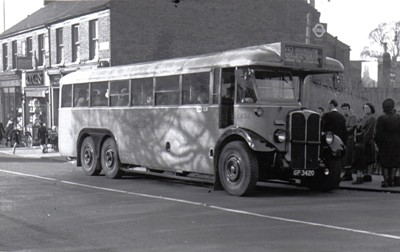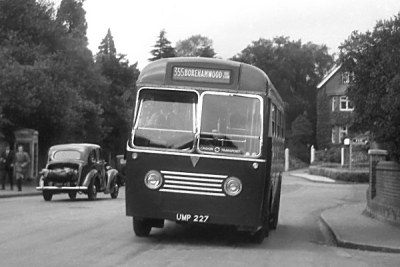 The RF Story The RF Story
Part 1 - Development
One of the predecessors of
the RF. This is an example of the LT-class six-wheel
single-deckers, known as 'Scooters', dating from around 1931.
Many, including this one, were rebuilt after the war to extend
their lives until the new RFs were available. LT1136 catches
winter shadows as it works towards Hounslow in February 1950.
The 237 was one of the first batch of Central Area routes to be
converted to RF operation. Photo © Alan Cross, Peter
Gomm collection
After the second world war, London Transport’s fleet needed
major renewal. First in line were the double-deckers, always
by far the largest part of the fleet. From 1947 to
1954, LT rapidly built up the largest fleet of standardised
double-deckers in the world, the RT
family. It also purchased 231 new single-deckers (the
TDs and post-war Ts), mostly of
essentially pre-war design. Meanwhile, it continued to run a
large number of elderly single-deckers, including Ts, Qs and LTs.
The AEC Q-type was a 1932 design that included a side-mounted
engine. Five years later, the Leyland TF appeared with
an underfloor-mounted engine laid on its side, providing the direct
forerunner to the RF. In both cases, moving the engine from
its traditional front position increased seating capacity within
the permitted bus dimensions of the time.
 The
AEC demonstrator UMP227 on loan to London Transport and working the
355 from St Albans to Borehamwood. The bus is now at the
London Bus
Museum ('Cobham') undergoing complete refurbishment. Photo © Geoff Morant, Mike Morant
collection
These design ideas were applied to the 1949 prototype AEC
Regal IV, UMP227, trialled by London Transport in 1950-1.
This high-floored bus had a centrally mounted underfloor engine,
again laid on its side. The flat front and front entrance (as
previously seen on some of the Q-class) gave maximum internal space
(as well as the potential for future one-man operation). The
trial, based at St Albans was a success and the RF was born.
The RF's AEC chassis carried a 9.6 litre diesel engine under
the floor with access via detachable panels on the offside.
Apart from changes arising from being laid on its side, this engine
was essentially similar to that carried by the RT.
Bodywork was provided by Metro-Cammell of Birmingham, previously a
supplier of trolleybus bodies but not buses. This came
about because Park Royal and Weymann were still busy with RT
orders; their output was originally to be complemented by 1,000
Metro-Cammell bodies of the same design for the Leyland-engined
RTL, but delays caused a change of plan, with the 700 RF bodies
being substituted for a reduction of 550 in the order for RTL
bodies.
Metro-Cammell bodywork had an excellent reputation for
durability and the RF has proved to be one of the most robust buses
ever built.
|